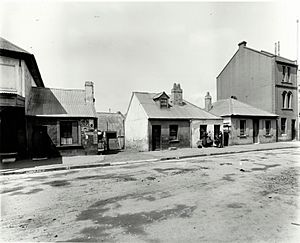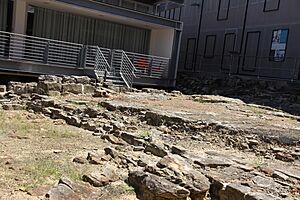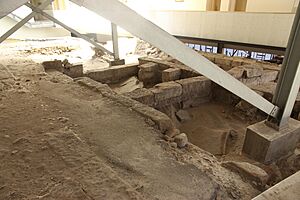Cumberland Street Archaeological Site facts for kids
Quick facts for kids Cumberland Street Archaeological Site |
|
|---|---|

Numbers 120–130 Cumberland Street, The Rocks, part of the archaeological site, pictured in October 1901.
|
|
| Location | 106-128 Cumberland Street, The Rocks, City of Sydney, New South Wales, Australia |
| Built | 1795– |
| Owner | Property NSW |
| Official name: Cumberland Street Archaeological Site; The Big Dig Site; Sydney YHA; Big Dig Education Centre | |
| Type | State heritage (archaeological-terrestrial) |
| Designated | 17 December 2010 |
| Reference no. | 1845 |
| Type | Townscape |
| Category | Urban Area |
| Lua error in Module:Location_map at line 420: attempt to index field 'wikibase' (a nil value). | |
The Cumberland Street Archaeological Site is a really important historical place in The Rocks, a suburb of Sydney, Australia. It's listed on the New South Wales State Heritage Register. This site holds the buried remains of some of Sydney's earliest homes. These homes date back to 1795, when the first European settlers arrived.
Today, a modern youth hostel, the Sydney YHA, stands above these old ruins. It's built in a special way so you can still see the historical remains below. This site is also known as The Big Dig Site or the Big Dig Education Centre. It's owned by Property NSW, which is part of the Government of New South Wales.
Contents
Discovering the Past: The Big Dig Site
The Cumberland Street Archaeological Site is like a giant history book buried underground. It shows us how people lived in Sydney from the very beginning of European settlement. This area was once part of two city blocks, Sections 74 and 75. People have lived here since at least 1795.
For many years, this area was a busy place. It was home to convicts and former convicts, as well as free settlers. Over time, more and more buildings were added. In the early 1900s, many buildings in The Rocks were knocked down. This site was cleared between 1902 and 1915. After that, it was used for different things, like workshops and a bus depot.
In 1994, archaeologists started digging here. This big excavation helped us learn a lot about the people who lived here long ago.
First Australians and Early Settlers
The Rocks area was the home of the Cadigal people, the traditional owners of this land. When the first European settlers arrived, both groups lived near each other for a while. Archaeologists found some interesting things during the 1994 dig. They found a piece of porcelain from after 1790 that Aboriginal people had shaped into a tool. This shows how they adapted to new materials.
Life for Convicts and Families
Many convicts and former convicts lived in The Rocks, including on this very site. It was a place where they lived and worked. One famous resident was George Cribb, a convict butcher. He arrived in 1808 and had a butcher shop and pub here until the late 1820s. There's even a lane named Cribbs Lane after him.
Another family, Ann Armsden and her husband George Legg, lived in a stone house nearby. This house was built into the sandstone rock. Some of these early families stayed in the area for many years. Their children and grandchildren continued to live there too.
Free settlers also moved into the area. Some married convict women. As more homes were built, more families settled here, especially from the 1830s onwards. The site was a lively neighborhood throughout the 1800s. It was only cleared in the early 1900s.
Busy Shops and Businesses
From the early 1800s, many people worked in different trades on this site. George Cribb had his butchery and pub. Later, Owen Caraher made candles and soap here in the 1860s. Carahers Lane is named after him.
A bakery was run by Thomas and James Share from the 1830s. Later, Robert Berry took over. People in the neighborhood used Berry's ovens to cook their Sunday dinners because most homes didn't have their own ovens. By 1889, there were about 33 houses, shops, and hotels on the site.
A Strong Community Spirit
The Cumberland Street site was a key part of The Rocks community. The Rocks was Sydney's first suburb. People from all walks of life lived here, rich and poor, convicts and free people. They often had strong bonds with each other.
Historical records show that children often lived close to their parents even after they grew up. Wives of sailors sometimes moved back home when their husbands were away at sea. Some families lived on the site for many generations. People even took in orphans of friends instead of sending them to institutions.
However, like any community, there were also challenges. Hotels were common, and homes were often small and crowded. This could lead to difficulties for some residents. The crowded streets and many pubs sometimes gave the area a bad reputation.
Government Changes and New Uses
In 1900, after a plague outbreak in Sydney, the government took over The Rocks area. They became the landlord for about 900 properties, including this site. The government wanted to clean up and redevelop parts of The Rocks. So, between 1902 and 1915, all the houses, shops, and hotels on this site were demolished. The people living there had to move.
For the rest of the 1900s, the site was used for different things. It was a machinery workshop, railway workshop, motor garages, and even a bus parking station. In the 1990s, the Sydney Cove Redevelopment Authority started the archaeological dig. This helped us rediscover the community that once lived here.
The Big Dig Today: 2006-2010

In 2006, Youth Hostels Australia won a competition to build a new hostel on the site. Their plan included a modern, energy-efficient hostel and an education center. Youth Hostels Australia is a non-profit group.
Construction of the Sydney Harbour YHA and The Big Dig Archaeology Education Centre happened between 2008 and 2009. During building, the old archaeological remains were carefully covered to protect them. The new buildings are supported by steel beams that span over the ruins. This means over 85% of the site can still be seen at ground level.
The Sydney Harbour YHA and The Big Dig Archaeology Education Centre officially opened in April 2010. It's one of the biggest urban archaeological projects in Australia. The building is raised above the ground, and old laneways have been rebuilt as paths through the site. There are even open spaces in the building to view the archaeology below. This design helps people learn about the site's early history.
What You Can See: The Site Description
The archaeological site has old building foundations and other historical layers. It's located between Cumberland Street and Gloucester Street.
The Youth Hostel (YHA) is built high above the excavated site. It also includes an archaeology education center. The YHA building is very light and is held up by only a few pillars. This design means it doesn't harm the old ruins. It also lets visitors see and walk through the site. You can see the ruins through openings in the building. Two old laneways, Cribbs Lane and Carahers Lane, have been rebuilt as paths. There are also displays of artifacts found during the dig.
How Well Preserved is the Site?
The site is very well preserved. In 1994, archaeologists dug up about 70% of the site. They found an amazing amount of historical items. Over 750,000 artifacts were recovered! The site still has about 60% of its remains from before 1830. It also has all the remains of eight terraces built in the 1840s-1850s.
The 1994 excavation uncovered many things. They found strong stone remains of at least 46 buildings. They also found post holes from timber structures, two main laneways, and stone-lined pits. These pits were used for waste or as wells. Most of these remains are still in place and in good condition.
Some parts of the site have not been dug up yet. These areas are still untouched. After the dig, some materials were added to protect the exposed remains. For example, wells were lined and filled in. Gravel and pebbles were also added for visitors to walk on.
All the 750,000 artifacts found are now stored safely off-site. The YHA building was built to protect and show off these archaeological treasures. The building is raised, and the old laneways are part of the design. There's even a special building for education about the dig.
Changes Over Time
- Around 1795-1901: The site was used for homes and businesses. Some buildings were knocked down in the early 1900s.
- 1917: Norton Griffiths machinery and joinery works used the site.
- 1918: City Railway Workshops were here.
- 1921-1924: A trade school for vocational training was on the site.
- 1925-1931: Motor garages operated here.
- 1951-1972: It became a bus depot for the Department of Road Transport and Tramways.
- 1972-1994: The site was used for storage.
- 1994: A major archaeological excavation took place.
- 2009: The Youth Hostel building was completed.
Why This Site is Important
The Cumberland Street archaeological site is very important for understanding Australia's history. It's a rare place that shows us what life was like for the first European settlers, especially convicts and former convicts, in The Rocks. It has the remains of 46 historic houses, two laneways, and other features. It's one of the few places in The Rocks where you can still see physical links to the very first settlement. This includes the huts and houses built into the sandstone rocks that gave "The Rocks" its name.
This site helps us understand events, processes, and people from the 1800s. Because so many people were involved in the 1994 excavation, it also has high social value. It's a "historic site" that looks unique and helps us imagine the past.
The archaeological importance of the site is ongoing. We are still learning from the excavated materials. The remains still in the ground can also give us more information. The site offers a unique "hands-on" way to experience Sydney's history. It's a great place for education.
The way the Youth Hostel was built over the site is a great example of how to protect and show off archaeological remains. It has won many awards for its design and heritage protection. Many people say it's one of the best examples in the world of keeping archaeological remains in place in a city.
The Cumberland Street archaeological site was added to the New South Wales State Heritage Register on 17 December 2010 because it meets several important criteria:
Showing Sydney's Early History
This site helps us understand the early days of Sydney. The Rocks was where many convicts and former convicts lived. The physical remains here show us what life was like for them. It's different from what official records might suggest. The way the houses were built shows how the settlement grew without strict rules.
The Rocks was a vital place for working-class people in the late 1700s and early 1800s. The things found here, like artifacts and building remains, show us how people lived. They challenge the idea that The Rocks was just a "slum" in the late 1800s. The old buildings help us imagine the living conditions of a community that no longer exists.
The site shows many important phases of Sydney's history. It went from being a few scattered homes to a busy area. Then, the government took over and cleared it. Later, it was used for industry and then became a storage area. Finally, it was excavated. This site is like a small example of how one of Australia's most lively communities changed over time.
Connecting to Important People and Groups
This archaeological site shows a small part of The Rocks community over more than a century. It has strong links to a major Sydney community and a part of New South Wales society. The historical research helps us learn about the people who lived here. Many of them were pioneers of Sydney, especially before the 1830s. We can connect actual building remains and artifacts to known individuals and families.
Unique Design and Achievement
As an excavated historical site, it has a clear visual quality. It fits well with the other historic buildings in The Rocks. You can see different layers of history in the site's features and remains. It's easy to recognize it as a historic place.
The excavation and redevelopment of the site from 2004-2010 is an excellent example of how to manage archaeology in Australia. The way the Youth Hostel was built over the site, protecting and showing the archaeology, has won many awards. It's considered one of the best examples of keeping archaeological remains in place in a city anywhere in the world.
The new youth hostel building has rebuilt the original laneways. This allows great views of most of the site's archaeology. You can see how the buildings and lanes were laid out in the early 1800s. These recreated views look like old historical photos from before the buildings were cleared.
Important to the Community
The Rocks is known as one of the birthplaces of Australia. As a place where early convicts settled, this site holds a special meaning. The community in The Rocks has a strong spirit and pride in its history. This site is one of the few places in The Rocks that still has a strong physical link to the first settlement. It shows the early huts and houses built on the rocky cliffs that gave "The Rocks" its name.
Thousands of people visited the site and took part in the 1994 excavation. This shows how much the community values it. Being able to see the physical evidence and learn about it helps people connect with the past.
Learning from the Past
Archaeological finds and historical documents together can tell us things we might not learn from documents alone. This site and the artifacts found here help us better understand the social, economic, and cultural history of Sydney and The Rocks community.
The excavation has already answered many questions about the site. It has helped us understand big historical topics. These include the impact of the Industrial Revolution, the rise of different social classes, and the lives of women. It also helps us understand the standard of living for working-class people and how the government's role changed over time.
Some parts of the site have not been excavated yet. These areas could provide even more information in the future. The physical remains and artifacts offer many opportunities for future research. They help us study important parts of Australian history, like convict life and early colonial settlements.
A Rare and Special Place
This archaeological site is believed to be the only large residential site in Sydney's Rocks that still has physical evidence from the very first settlement. It contains an entire neighborhood. The 1994 dig found huge numbers of artifacts and many building remains. These survived because later building work in the 1900s didn't disturb them much.
Many other places in Australian cities have had their historical layers removed by modern construction. But this site is different. Any area that can preserve remains from 1800s Sydney, especially from the early part of the century, is very rare and important.
Showing Key Features of Historical Places
The site was continuously occupied from the late 1700s through the 1800s. This allows us to see how society changed over time, especially how home life and living spaces evolved. The evidence here shows us what individual homes and a whole community were like during this period. It gives us a physical, "hands-on" way to understand how people lived long ago compared to today.




